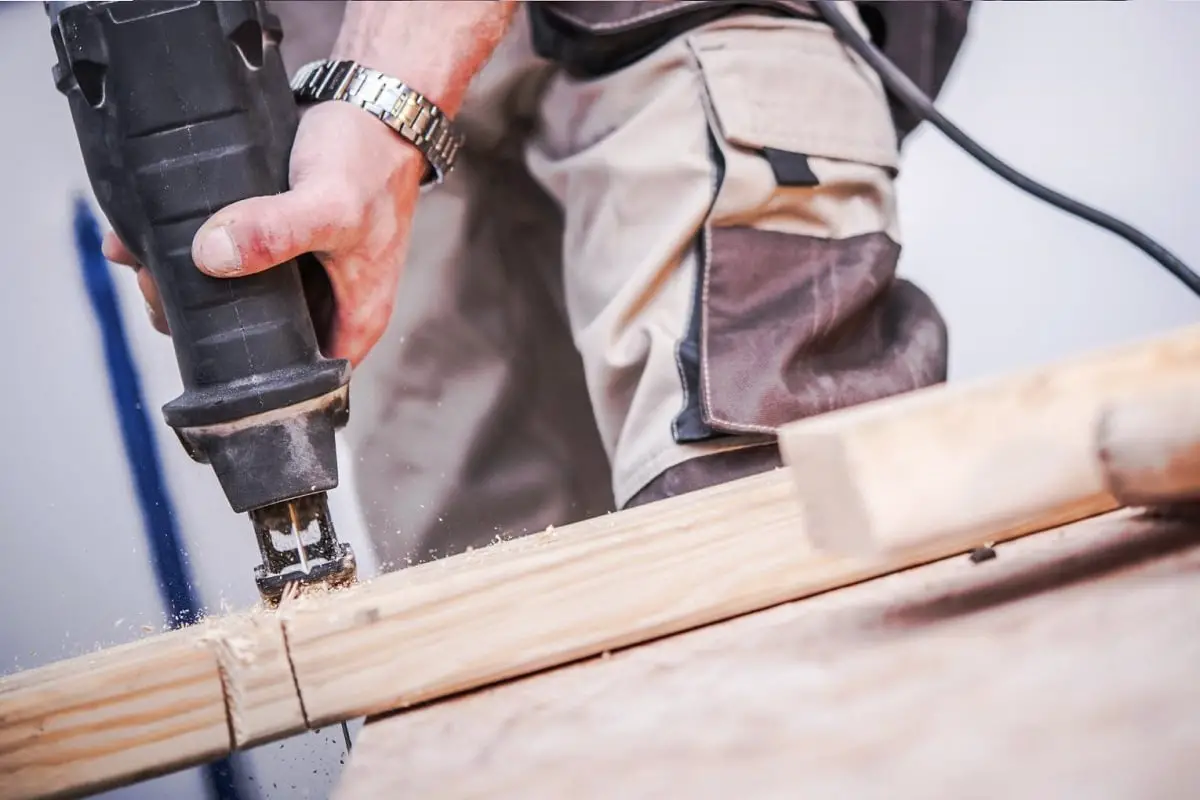Reciprocating saws are known for being tough. But how long do they last? Find out in this post.
Parts Of A Reciprocating Saw
Reciprocating saws are made of various parts, each one of which can break or wear out. These include:
- Blade
- Shoe
- Blade clamp / blade release
- Trigger
- Battery / cord
- Front grip
- Rear handle
- Orbital setting
- Vents
- Motor
Each one of these can be damaged through wear and tear, dust build up, contact with water or moisture, rust, etc.
Dropping A Reciprocating Saw
What happens when you drop a reciprocating saw? How many times can one be dropped before it stops working?
There is no rule for the number of times a reciprocating saw can be dropped before it breaks. However, doing so is not recommended. This could shorten the lifespan of the saw.
It could bend or break the blade, crack the body or rear handle, knock the trigger mechanism lose, or harm the motor. What is most likely to happen is the plastic casing around the saw or battery will crack. This could mean they may or may not keep working.
Dropping a reciprocating saw could also knock some of the electrical components in and around the motor loose, which could render it non-functional.
Even so, in busy work environments, the dropping of power tools happens from time to time. This is why reciprocating saws are made to be tough.
Reciprocating Saw Handle

A reciprocating saw should not be used if the handle is broken. This could put the operator at risk of injury. The way to make sure is to inspect the handle prior to each use. If it feels shaky or loose or there is a noticeable crack running through it, then do not use the saw.
Reciprocating saw handles can be replaced with a new one from the manufacturer. This may not be worth the effort because it takes time and you need to take apart the saw to fit it in place.
Reciprocating Saw Motor
A big decider on how long a reciprocating saw will last is the lifespan of the motor. This depends on several factors, one of which is the type of motor it is.
Types Of Reciprocating Saw Motors
Reciprocating saws are electric and do not run on gas. There are two types of reciprocating saw motors:
- Brush
- Brushless
A brushless motor does not use brushes but instead uses a computer and electromagnets to transfer electricity to the rotating component. This minimizes friction in the motor and can increase the lifespan of the saw.
Reciprocating saws that use electric motors with brushes are thought to wear out faster. The brushes may need to be replaced in time. Brush motors also tend to get hotter and cool down slower which can reduce overall durability.
Eventually the motor bearings may start to get noisy, but this can be remedied by opening the saw and dropping a bit of oil on them.
Reciprocating saws are water and dust resistant, but they can be damaged by too much exposure to both. Electric motors can be damaged by these as well as dropping the saw or driving it too hard until it overheats.
Durable Reciprocating Saws
BLACK+DECKER 20V MAX Cordless Reciprocating Saw Kit
Skil 9206-02 7.5-Amp Variable Speed Reciprocating Saw
DEWALT Reciprocating Saw, Corded, 12-Amp
Is A Reciprocating Saw Waterproof?
Reciprocating saws are generally not water-proof, but they are usually water-resistant. This means they can handle some contact with water droplets and mist without becoming damaged.
Can A Reciprocating Saw Be Submerged In Water?
No, a normal reciprocating saw will be damaged if it is submerged in water.
Waterproof Reciprocating Saw
However, special underwater reciprocating saws exist. These are designed for use by professional divers and underwater rescue crews. These are electric, battery powered, waterproof reciprocating saws that can be fully submerged without being damaged.
Nemo Power Tools offers a submersible reciprocating saw that they claim provides the same level of cutting ability as their dry-land counterparts.
Reciprocating Saw Lifespan
So, how long will a reciprocating saw last? This depends on how it is used and which part of the saw breaks or wears out first.
A reciprocating saw can last anywhere from a few months to a few decades. This depends on how it is used and maintained. A good quality reciprocating saw can last many years of use. Some owners have reciprocating saws 20+ years old sitting in their garage that still work great!
The blades will wear out far earlier than the saw itself. Even the best quality blades will wear out when cutting hard materials. This could be anywhere from a few hours to a few weeks of use. Blade lifespan can be extended using special blade lubricant and wiping away moisture to prevent rust.
It is also important to only use blades that match the material and the proper length. A blade that is too long is likely to bend due to too much waggle while cutting.
In Closing
All in all, reciprocating saws are made to be rugged and handle abuse. This means they are likely to last a good long time with continuous use.
More important, however, is staying safe when using one. A broken reciprocating saw can be repaired or replaced, but your hands, eyes, or hearing may be permanently damaged in an accident.

